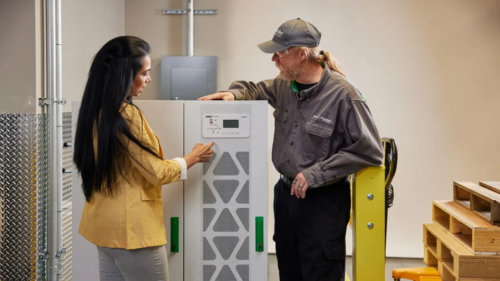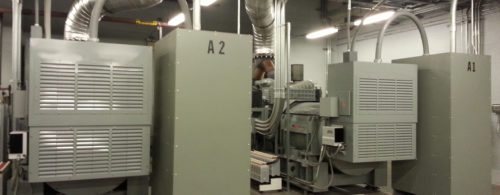Entertainment Technology Flies High at Air Zoo
The Air Zoo in Kalamazoo, Mich. is not your run-of-the-mill air museum by any stretch of the imagination. Oh sure, it has vintage aircraft and other items you would expect to find in gallery devoted to the history of aviation. But inside the 90,000-square-foot facility are also a couple of full-sized carnival rides; advanced flight simulators; a Space Shuttle simulator that allows visitor to take a virtual flight to a space station; a 60-seat, sense-surround 3D theater that recreates a bombing run over WWII Germany; and the world’s largest indoor mural, at 32 feet high and more than 1,000 feet long.
Because Air Zoo is a “living” museum, rather than simply a building filled with static displays, lighting the hybrid facility was a challenge for lighting designer Bill Hunter of Hunter-Leet & Associates, a Kalamazoo, Michigan based lighting design, consulting and contracting firm. With displays that were often moving – only the carnival rides have permanent homes in the museum – Hunter needed a lighting system that was flexible and moveable as well. He couldn’t be tied down with a traditional rack-mounted dimming system. Instead, he used 48 six-pack IPS dimmer boxes from Entertainment Technology.
“The place is just too big, to install conventional theatrical distribution,” Hunter explained. “The cost of doing theatrical style raceway and racks would have been astronomical. I can get the same amount of dimming from the Entertainment Technology dimmer boxes.”
With the 48 dimmer boxes, the museum is equipped with what essentially amounts to three racks of dimming. Because the boxes can be distributed throughout the museum where the loads are needed, Hunter was able to simply cord-connect the fixtures with the dimmers rather than having to pipe raceway from remote dimmer racks. This also leaves Air Zoo free to re-arrange its exhibits with only a fraction of the effort and expense.
Because the IPS dimmer boxes are IGBT-based, they are short-circuit proof, which provides exhibit designers additional peace of mind knowing the equipment won’t malfunction from being repeatedly connected and disconnected as the exhibits and equipment are moved around.
“When they decide to move one of the planes to a different location, all I have to do is move a dimmer box,” Hunter said. “At the very worst, all I’m going to need to do is make a four-pole and ground extension cord for it.”
In the early planning stages of the project, Hunter notes, the natural assumption was to use traditional racks and raceways. But when the cost of the system was added up, it was not financially feasible.
(Photo: Jim Hunter)
“When I started looking at the numbers – not just materials, but also in labor to pull all the wiring and run all the pipe – it came up about four times over budget before I ever presented it,” Hunter explained. “So I went back to the drawing board, and the Entertainment Technology dimmer boxes became the way to go.”
Lighting the museum are more than 200 conventional fixtures, all of which are powered through the six-pack dimmer boxes. Hunter distributes the DMX over Cat5. Every place where there is a power drop, there is data distribution. Each dimmer is independently controlled within the system. The exhibit runs on automation, or it can be run through manual override units. There are no architectural wall stations.
“This is a really good application for the Entertainment Technology gear,” said John Hyatt of John Hyatt & Associates, the Grand Rapids, Mich.-based company that provided the Entertainment Technology gear. “We looked at using conventional gear, but it made a lot more sense to go with distributed dimming.”
And why not use a 12-pack dimmer box rather than the Entertainment Technology six pack?
“I didn’t need a dimmer pack with 12 dimmers, I needed a six pack,” Hunter says matter-of-factly. “It would have been twice as labor intensive to run cable from 12 fixtures back to one pack, especially when you’re on lifts 40 feet in the air. If I ever needed 12 dimmers in one place, I could just hang a second pack.”
Air Zoo owners wanted the museum to be as interactive and family-oriented as possible. To accomplish this objective, Hunter relied on theatrical lighting techniques rather than traditional static-display museum lighting. The Entertainment Technology dimmer boxes allowed him this flexibility.
As visitors enter the Air Zoo and look to the left, the history of flight starts with hot air balloons, working its way to bi-planes, WWII fighter planes, on to airplanes used in the Korean War, a two-thirds scale replica of an aircraft carrier superstructure, and finally, to space travel. Rather than just bathe the aircraft and exhibits in light, Hunter highlighted specific details of each aircraft.
“The dimmer boxes were an obvious choice for me because they’re small and lightweight,” Hunter explained. “I didn’t need a tremendous amount of dimming capacity because the owner didn’t want me to just throw light at stuff. He wanted me to be very specific in what I lit*which was sometimes quite a feat from 30 feet in the air where the fixtures were located.”
One exhibit includes an F-14 fighter plane with a skull and crossbones on each of the tail stabilizers. Hunter focused the fixtures to draw attention to those highlights. In order to create those types of looks, he needed the flexibility to position the fixtures exactly where they were needed.
The overall effect throughout the Air Zoo is tremendous.
Do you have experience and expertise with the topics mentioned in this content? You should consider contributing to our CFE Media editorial team and getting the recognition you and your company deserve. Click here to start this process.




